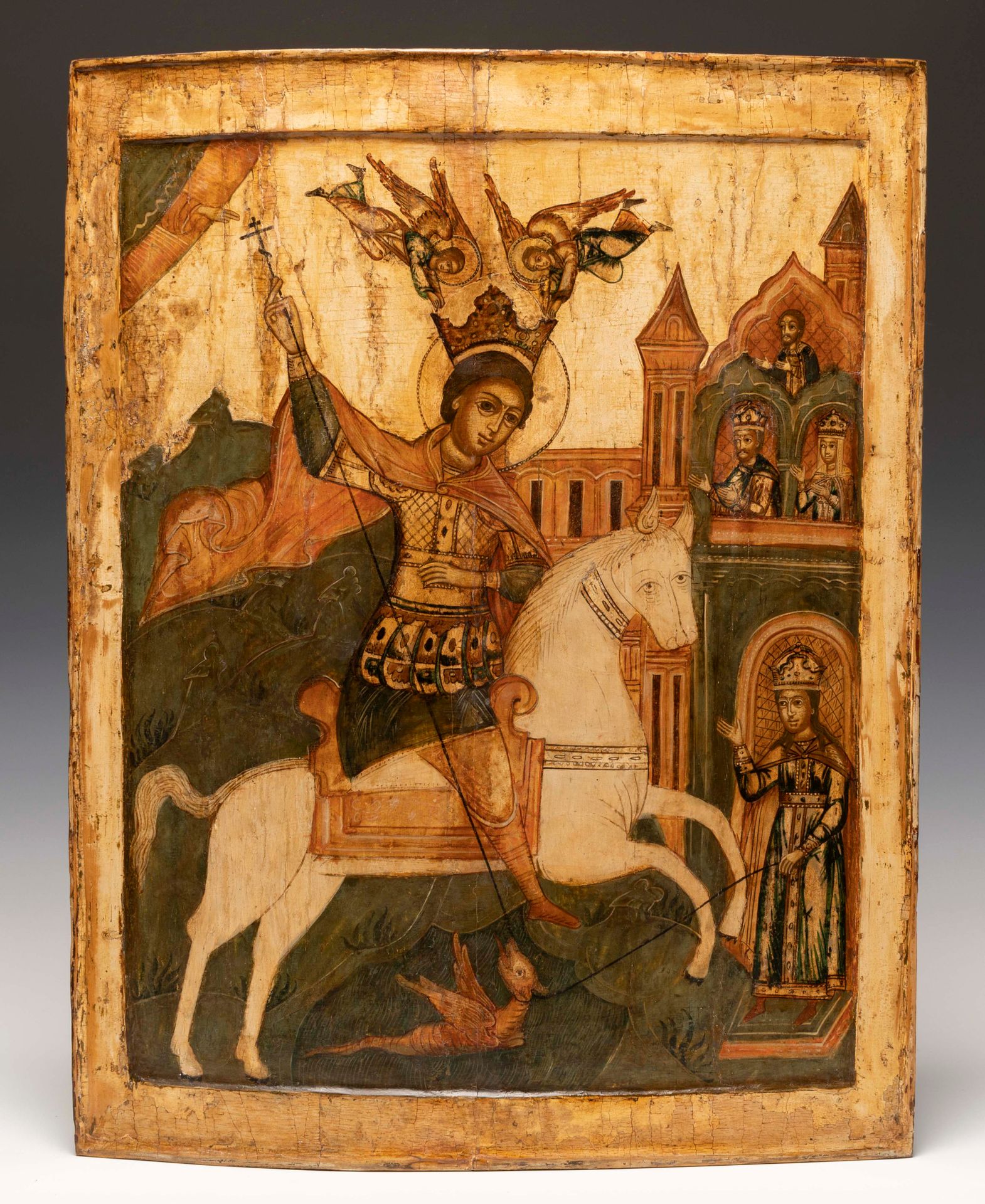Description
Northern Russian icon, 18th century. "San Jorge fighting the dragon". Tempera and levkas on wood. It presents small restorations. Measurements: 71 x 54 cm. The icon we are dealing with represents Saint George saving Elisaba, the daughter of the pagan king of Selena, in Libya, who holds the dragon with a leash and is blessed by the king and the queen who witness the scene. By thrusting his spear into the dragon's mouth, St George frees the city from its clutches, which were blocking the water supply, as well as Elisaba, who had been chosen as a ransom by the dragon. Two angels crown the saint while Christ blesses him. The legend of St George is one of the most recurrent passages in Christian literature and iconography. The first mentions of St George as a martyr appear as early as the 5th century, and are initially limited to a specific territory: Cappadocia (the legend says it was his birthplace), Nicomedia and Diospolis (Lydia). According to the earliest versions of hagiography, George suffered torture at the hands of the Persian king Dadian; this figure was later replaced by the historical figure of Emperor Diocletian. In the period after the iconoclastic period, around the 11th century, the story of George's numerous tortures was supplemented by a developed cycle of miracles. It is believed to have been created mainly in Eastern monastic circles. The most popular of the miracles, "The Miracle with the Dragon", is the one depicted on our icon in the central square. This legend dates back to the oral tradition of the 8th century; it is not recorded in manuscripts for the first time until the 12th century. However, these dates may vary in different historical sources. In Russia, the cult of St George began to gain popularity around the 11th century, coinciding with the reign of Yaroslav the Wise. In both Byzantine and Russian Orthodox art, depictions of St George with hagiographic scenes are rather rare and scarce compared to other popular saints. The curious detail of the present icon is the central scene, which depicts St George on horseback slaying the dragon. Only in the early Muscovite tradition and in the Byzantine tradition itself does the central scene depict St George standing upright and full-length; in all other interpretations of the scene St George appears as he does in the present icon. The symbolism of this particular iconography goes back to early Christian beliefs, which form practically the basis of all Christianity, of the struggle between good and evil. This is one of the reasons why the theme of Saint George is so recurrent throughout history.
2
Northern Russian icon, 18th century. "San Jorge fighting the dragon". Tempera and levkas on wood. It presents small restorations. Measurements: 71 x 54 cm. The icon we are dealing with represents Saint George saving Elisaba, the daughter of the pagan king of Selena, in Libya, who holds the dragon with a leash and is blessed by the king and the queen who witness the scene. By thrusting his spear into the dragon's mouth, St George frees the city from its clutches, which were blocking the water supply, as well as Elisaba, who had been chosen as a ransom by the dragon. Two angels crown the saint while Christ blesses him. The legend of St George is one of the most recurrent passages in Christian literature and iconography. The first mentions of St George as a martyr appear as early as the 5th century, and are initially limited to a specific territory: Cappadocia (the legend says it was his birthplace), Nicomedia and Diospolis (Lydia). According to the earliest versions of hagiography, George suffered torture at the hands of the Persian king Dadian; this figure was later replaced by the historical figure of Emperor Diocletian. In the period after the iconoclastic period, around the 11th century, the story of George's numerous tortures was supplemented by a developed cycle of miracles. It is believed to have been created mainly in Eastern monastic circles. The most popular of the miracles, "The Miracle with the Dragon", is the one depicted on our icon in the central square. This legend dates back to the oral tradition of the 8th century; it is not recorded in manuscripts for the first time until the 12th century. However, these dates may vary in different historical sources. In Russia, the cult of St George began to gain popularity around the 11th century, coinciding with the reign of Yaroslav the Wise. In both Byzantine and Russian Orthodox art, depictions of St George with hagiographic scenes are rather rare and scarce compared to other popular saints. The curious detail of the present icon is the central scene, which depicts St George on horseback slaying the dragon. Only in the early Muscovite tradition and in the Byzantine tradition itself does the central scene depict St George standing upright and full-length; in all other interpretations of the scene St George appears as he does in the present icon. The symbolism of this particular iconography goes back to early Christian beliefs, which form practically the basis of all Christianity, of the struggle between good and evil. This is one of the reasons why the theme of Saint George is so recurrent throughout history.
